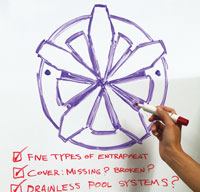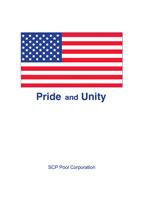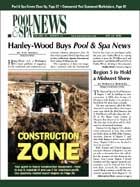The decade started out quietly enough. After all, Jan. 1, 2000, wasn’t perceptibly different than Dec. 31, 1999.
The industry was still honing its skills in pool and spa design, with the increasing use of vanishing-edge and perimeter-overflow vessels and various types of waterfeatures, even on vinyl-liner and fiberglass pools.
Retailers and builders alike were broadening their products and services to include virtually all backyard amenities.
Meanwhile, service technicians were familiarizing themselves with increasingly sophisticated technologies.
On a less positive note, the National Spa & Pool Institute was still trying to find its way after being forced into bankruptcy by the landmark Meneely diving case. And a relatively obscure phenomenon called entrapment was gaining public attention.
Yet business owners of all stripes continued to enjoy an economic growth spurt that had started in the late 1990s. And the World Wide Web was graduating from a novelty into a legitimate business platform.
Strangely, the years from 2000 to 2010 were almost like two decades — the one before and after the fall of 2008. During the first part, the pool market expanded into a builder-dominated gargantuan barely able to keep up with demand. In the second chapter, not only did the industry shrink like the rest of the construction segment, but it favored service companies, retail and renovation. Like it or not, this industry would be changed forever.
Ups and downs
At the turn of the century, the economy was chugging along, and carrying the industry with it. Builders were king, and home-owners were opening their minds and wallets to more and more products — not only elaborate waterfeatures and vanishing edges, but outdoor kitchens, fireplaces and other amenities.
The market dipped briefly after the dot-com bubble burst, followed directly by the events of 9/11. But by the end of 2003, the industry was in fine form. In fact, the country had entered a new era where home values seemed to endlessly skyrocket, offering previously unknown equity to consumers.
On top of this, financial institutions became increasingly freewheeling, valuing homes at 100 percent of inflated prices and offering mortgages with little to no down payments. New-home construction remained at historically high levels, and with it, pool digs. So steady were housing starts that some pool contractors began to work exclusively with home builders.
Because of the easy credit and high equity, everybody moved up a notch in their pool and spa purchases. Those who a few years earlier would have bought aboveground pools now purchased entry- to mid-level ingrounds. Middle-class families were signing on to $50,000 projects, with some exceeding $100,000.
Meanwhile, high-end installations reached new realms of extravagance, with some wealthy homeowners even purchasing lots next door to their houses just to accommodate large, elaborate waterscapes. Others hired contractors to raze relatively new pools and replace them with something to their exact specifications.
But in later in the decade, many builders began to see sales drop and realized they couldn’t count on their companies to continue growing by double digits each year from sheer demand.
Business owners tried to put the situation in perspective. “The problem is, do we compare [now] to the absolutely bonker days of 2005 and early 2006, when the market was just hyper? Or do you compare it to 2001 and 2002, before the housing boom?” one builder asked in 2007.
While some younger professionals struggled to find their compasses, veteran builders who had been through previous recessions took the situation in stride … at first. “We’ve been through this before; we’ll go through it again,” they figured.
“Maybe a return to these numbers isn’t such a bad thing,” another builder commented. “It’s funny. The one thing that time will do is get people to stop remembering 3 percent loans, 4 percent money. That was Fantasy Land. It was fun to do, but it wasn’t our real world. Today’s 6½ to 8 percent money — it was only a few short years ago that we used to think that was pretty good.”
Florida, Phoenix and a few other previously red-hot markets became a barometer of things to come, when companies reported declines of 60- to 80 percent, with foreclosures going through the roof and financing grinding to a complete halt.
“[Even] if you’re Zig Ziglar trying to sell pools, this market is tough,” said Ron Ostlund, president of now-defunct Riviera Pools in Phoenix.
In September 2008, any remaining denial was laid to rest when the stock market crashed and many financial institutions were forced to shut their doors. The following year brought a blur of company closures, restructuring, redefining, paring down of expenses and diversification.
Though many companies went under, the industry’s shrinkage was not nearly commensurate with the reduction in pool starts.
Resilience and innovation played a large role in the survival rate, with firms shifting gears by focusing more on renovation work and expanding their service departments. In addition, commercial construction saw one more year of activity, becoming an important income stream for some companies.
Those who acted quickly fared better. Previous business practices also affected a company’s outcome with those who had remained conservative about accumulating debt during the boom having better survival rates.
Industry changes occurred not only in the size of the market, but in the philosophies of many professionals as well. Companies became lean and mean, with owners vowing never again to allow overhead to reach the levels it had. Today’s business owners are checking their financials much more often to constantly monitor costs and remain nimble in the present environment.
Other side effects of the economy have been more controversial. Most notably, many say that price competition has been fierce to the point of damaging. In some cases, builders report losing jobs to competitors who bid projects at 20- and 30 percent less, and many worried that this pricing mentality was going to set the industry’s image back 30 years.
With 2010 and 2011 bringing modest increases, the siege has loosened a bit, but the next few years will tell how the industry wears its new size.
Going green
As energy costs continue to rise and fall capriciously, and power grids become more and more overloaded, utilities and government agencies have looked for any way they can to promote conservation.
In 2005, the California Energy Commission released the state’s Title 20 and 24, meant to require manufacturing and construction practices, respectively, to make various products, including pools and spas, more energy-efficient.
The old saying, that “As California goes, so goes the rest of the country,” has applied here. So far, a number of states, including Florida and New Jersey, have instituted similar laws.
The industry responded with products and programs that cut energy use. Variable-speed pumps entered the market, making it possible to run a circulation system as slowly as possible and, when needed, boost the output for features such as automatic cleaners, vanishing edges and waterfalls.
On the construction and service end, not only have some professionals become active advocates for variable-speed pumps, but others have created sideline businesses installing solar and geothermal heating systems.
Industry associations have also taken part in the effort. The Foundation for Pool and Spa Industry Education has begun a program in Sacramento County teaching professionals how to work with local utilities to audit pools and spas for energy efficiency. The classes are expected to go nationwide.
As public utilities look for more ways to entice homeowners to control energy use, such as charging higher rates during peak hours, these technologies become even more relevant.
The Internet
It was clear in the 1990s that the Internet would become a force that the industry would have to define and negotiate. But toward the end of last decade, as companies did everything they could to survive the recession, some began to see Web-based firms as a more ominous threat.
“There’s not going to be a pool industry left, because now we’re not allowed to make money on anything,” said Randy Budd, president of Budd’s Pool Co. in Deppford, N.J., in 2010.
It was bad enough losing business to other companies willing to sell products for less money, but many professionals came to believe that the Internet has an unfair advantage — namely a perceived lack of overhead and ability to “drop-ship” directly from manufacturers to consumers. Retailers had always felt the heat from Websites, but now the pressure was extending to builders and service technicians, who were increasingly being asked to install equipment purchased off the Internet.
Today, some brick-and-mortar outfits would like to see checks and balances put in place to even the playing field. The most talked-about solution is large-scale minimum advertised pricing (MAP), a program whereby manufacturers set a limit as to how low prices can be publicized. Some manufacturers have tried this strategy with desired results, while others say it requires too much policing, and that there are ways to get around the requirement.
Meanwhile, service and construction companies have grappled with what to do when customers ask them to install equipment they purchased online. At first, many flat-out refused. But as the economy stumbled and Web purchases became increasingly common, some have found ways to work with these products and still profit.
“For the longest time our mindset was, ‘You bought it on the Web? Good luck. Have a nice life,’” said Bruce Bagin, a partner at B and B Pool and Spa Center in Chestnut Ridge, N.Y., in 2010. “But … I changed my attitude. I stepped back and am not taking it personally.”
Moments in Time – The ’00s
HEADLINE NEWS:
NSPI Expo Sold to Hanley-Wood / Hanley-Wood Buys Pool & Spa News
In March 2001, the National Spa & Pool Institute sold its annual trade show to raise funds to pay out a lawsuit verdict. The new owner, Hanley-Wood, LLC, then purchased Pool & Spa Newsfrom Leisure Publications in June.
FITTING TRIBUTE:
As the nation mourned after Sept. 11, 2001, SCP PoolCorp. ran an ad commemorating the tragedy and highlighting America’s national strength.
FACES OF CHANGE:
The passage of the first federal pool and spa safety law came about largely because of tragedies suffered by four children and their families.
In 2000, 14-year-old Lorenzo Peterson was entrapped in a main drain, causing injuries that ended his life four years later. In 2003, he and his family were granted a record-breaking judgment of $104 million from the pump manufacturer. The award eventually was overturned and a confidential settlement reached, but the attention helped put entrapments on the map.
But it was a 2002 incident that undid the relative obscurity of entrapment hazards. Seven-year-old Virginia Graeme Baker, granddaughter of former Secretary of State James Baker, drowned when her body was entrapped on an inground spa drain. Her mother, Nancy, became a high-profile safety advocate, and today the law bears her daughter’s name. (The 2006 photo above shows, L-R, James and Nancy Baker; VGB author Rep. Debbie Wasserman Schultz; and Dr. Martin Eichelberger, then-CEO of Safe Kids Worldwide.)
But the road to pass VGB wasn’t easy. A 2006 attempt failed. Then, in the summer of 2007, a second bill was struggling to gain traction when two 6-year-olds suffered entrapments within the span of a month.
Abigail Taylor’s occurred in an older commercial spa, while Zachary Archer Cohn’s happened in his family’s relatively new pool.
Their deaths put entrapment hazards in the national spotlight and instantly revived the foundering bill, propelling legislators in the children’s home states to become sponsors.
In response to Abigail’s death, legislators added a section devoted to commercial pools and spas, which became the most potent part of the bill. By year’s end, the legislation passed.
PATRIOTIC DUTY:
Many in the industry have served in the Middle East since 9/11. Lt. Col. Jim Stearns, owner of Stearns Pools & Spas in Stafford, Texas, supervised reconstruction of Saddam Hussein’s personal pools to be used by the troops. Known as“The Pool Sheik,” he also solicited pool supplies from America. “It is unbelievable how much those pools mean to them,” he told Pool & Spa News in 2005.
IMPORTANT STEP:
In fall 2006, approval was given to ANSI/APSP-7 American National Standard for Suction Entrapment Avoidance in Swimming Pools, Wading Pools, Spas, Hot Tubs and Catch Basins. The standard has been used to supply language for building codes and safety regulation throughout the country
HEADLINE NEWS:
Pool Builder Charged in Entrapment Death
For the first time ever, a builder was arrested for a drowning in a pool his company constructed. In 2008, David Lionetti of Shoreline Pools in Stamford, Conn., was charged with second-degree manslaughter after 6-year-old Zachary Archer Cohn became entrapped and drowned. In 2011, Lionetti pled guilty to a misdemeanor, while his company bore the felony. He was sentenced to community service, while Shoreline will contribute substantially to a non-profit group begun by Zachary’s parents.
WILL WORK FOR GAS:
With the economic downturn came another spike in fuel prices, leaving service firms and contractors in search of new ways to stretch the liquid gold. It also inspired one of the most amusing photo illustrations produced in Pool & Spa News.
- The ’60s
- The ’70s
- The ’80s
- The ’90s
- The’00s









